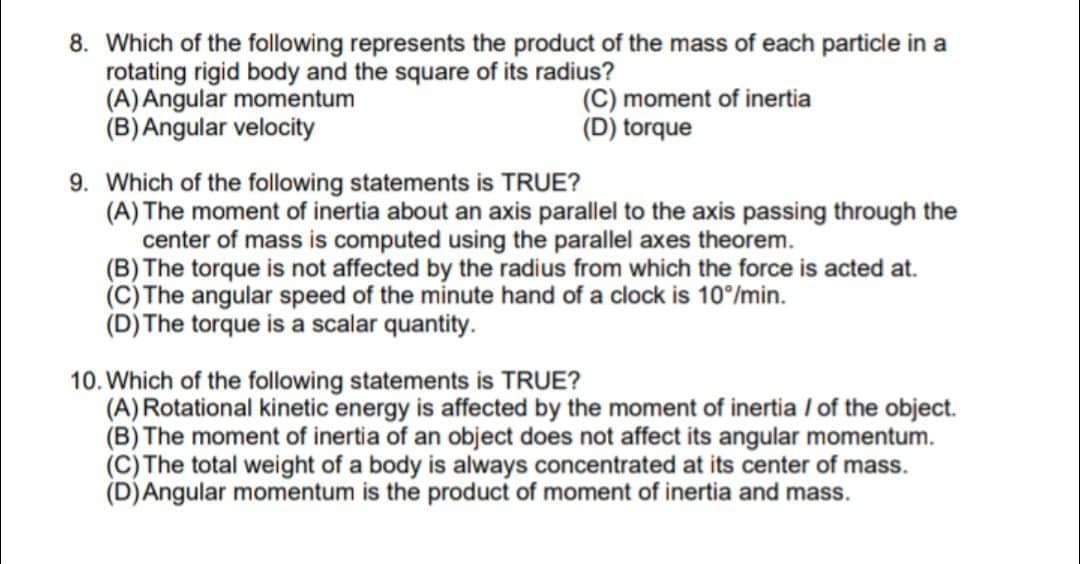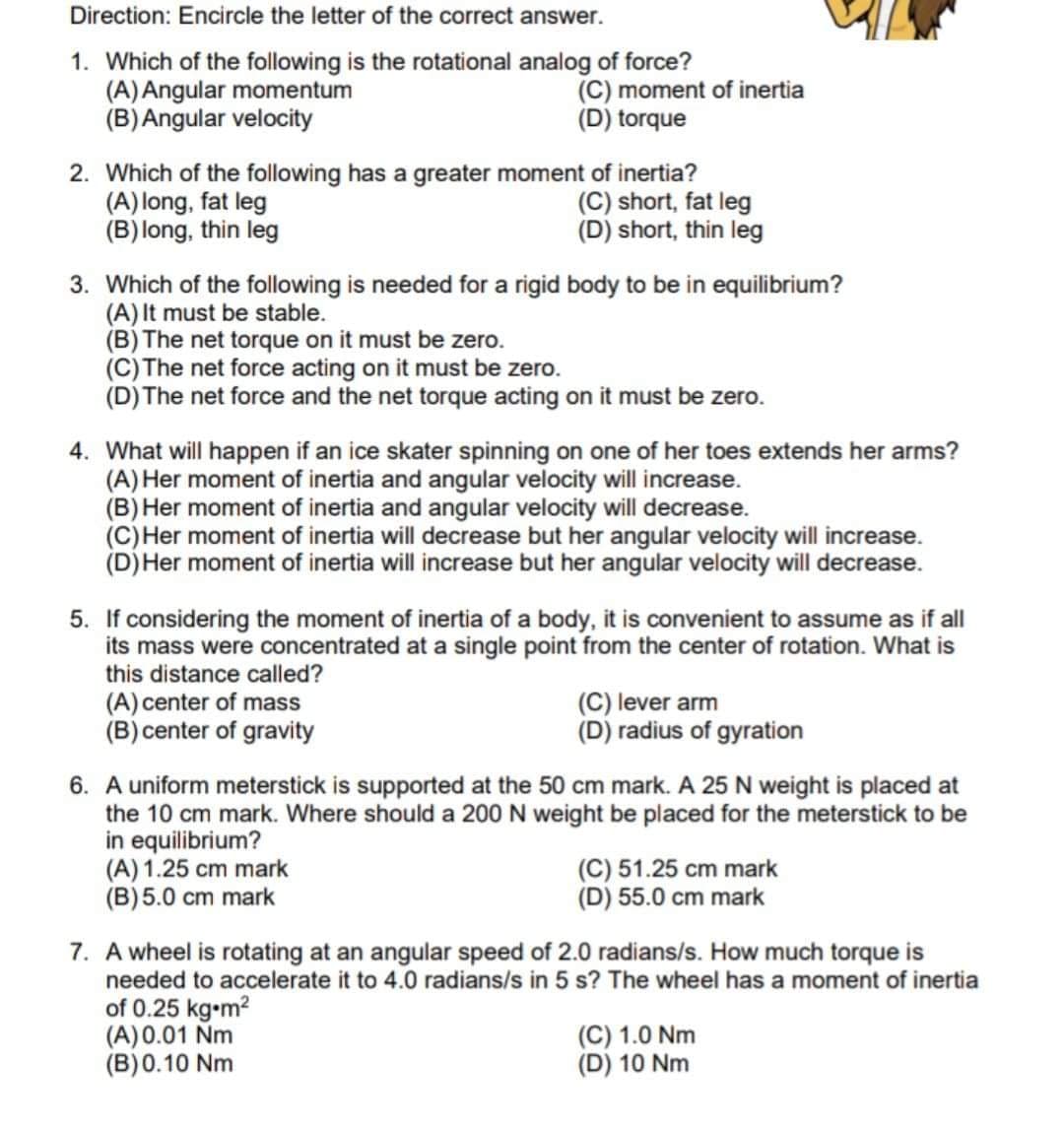1. Which of the following is the rotational analog of force? (A) Angular momentum (B)Angular velocity (C) moment of inertia (D) torque 2. Which of the following has a greater moment of inertia? (A) long, fat leg (B) long, thin leg (C) short, fat leg (D) short, thin leg 3. Which of the following is needed for a rigid body to be in equilibrium? (A) It must be stable. (B) The net torque on it must be zero. (C) The net force acting on it must be zero. (D) The net force and the net torque acting on it must be zero.
1. Which of the following is the rotational analog of force? (A) Angular momentum (B)Angular velocity (C) moment of inertia (D) torque 2. Which of the following has a greater moment of inertia? (A) long, fat leg (B) long, thin leg (C) short, fat leg (D) short, thin leg 3. Which of the following is needed for a rigid body to be in equilibrium? (A) It must be stable. (B) The net torque on it must be zero. (C) The net force acting on it must be zero. (D) The net force and the net torque acting on it must be zero.
College Physics
1st Edition
ISBN:9781938168000
Author:Paul Peter Urone, Roger Hinrichs
Publisher:Paul Peter Urone, Roger Hinrichs
Chapter10: Rotational Motion And Angular Momentum
Section: Chapter Questions
Problem 15PE: Consider the 12.0 kg motorcycle wheel shown in Figure 10.38. Assume it to be approximately an...
Related questions
Question
Answer 1-10 , no need for solutions

Transcribed Image Text:8. Which of the following represents the product of the mass of each particle in a
rotating rigid body and the square of its radius?
(A) Angular momentum
(B)Angular velocity
(C) moment of inertia
(D) torque
9. Which of the following statements is TRUE?
(A) The moment of inertia about an axis parallel to the axis passing through the
center of mass is computed using the parallel axes theorem.
(B) The torque is not affected by the radius from which the force is acted at.
(C) The angular speed of the minute hand of a clock is 10°/min.
(D) The torque is a scalar quantity.
10. Which of the following statements is TRUE?
(A) Rotational kinetic energy is affected by the moment of inertia / of the object.
(B) The moment of inertia of an object does not affect its angular momentum.
(C) The total weight of a body is always concentrated at its center of mass.
(D)Angular momentum is the product of moment of inertia and mass.

Transcribed Image Text:Direction: Encircle the letter of the correct answer.
1. Which of the following is the rotational analog of force?
(A) Angular momentum
(B)Angular velocity
(C) moment of inertia
(D) torque
2. Which of the following has a greater moment of inertia?
(A) long, fat leg
(B)long, thin leg
(C) short, fat leg
(D) short, thin leg
3. Which of the following is needed for a rigid body to be in equilibrium?
(A) It must be stable.
(B) The net torque on it must be zero.
(C)The net force acting on it must be zero.
(D) The net force and the net torque acting on it must be zero.
4. What will happen if an ice skater spinning on one of her toes extends her arms?
(A) Her moment of inertia and angular velocity will increase.
(B) Her moment of inertia and angular velocity will decrease.
(C) Her moment of inertia will decrease but her angular velocity will increase.
(D)Her moment of inertia will increase but her angular velocity will decrease.
5. If considering the moment of inertia of a body, it is convenient to assume as if all
its mass were concentrated at a single point from the center of rotation. What is
this distance called?
(A) center of mass
(B) center of gravity
(C) lever arm
(D) radius of gyration
6. A uniform meterstick is supported at the 50 cm mark. A 25 N weight is placed at
the 10 cm mark. Where should a 200 N weight be placed for the meterstick to be
in equilibrium?
(A) 1.25 cm mark
(B)5.0 cm mark
(C) 51.25 cm mark
(D) 55.0 cm mark
7. A wheel is rotating at an angular speed of 2.0 radians/s. How much torque is
needed to accelerate it to 4.0 radians/s in 5 s? The wheel has a moment of inertia
of 0.25 kg-m2
(A)0.01 Nm
(B)0.10 Nm
(C) 1.0 Nm
(D) 10 Nm
Expert Solution
This question has been solved!
Explore an expertly crafted, step-by-step solution for a thorough understanding of key concepts.
This is a popular solution!
Trending now
This is a popular solution!
Step by step
Solved in 3 steps with 3 images

Knowledge Booster
Learn more about
Need a deep-dive on the concept behind this application? Look no further. Learn more about this topic, physics and related others by exploring similar questions and additional content below.Recommended textbooks for you

College Physics
Physics
ISBN:
9781938168000
Author:
Paul Peter Urone, Roger Hinrichs
Publisher:
OpenStax College

Glencoe Physics: Principles and Problems, Student…
Physics
ISBN:
9780078807213
Author:
Paul W. Zitzewitz
Publisher:
Glencoe/McGraw-Hill

Physics for Scientists and Engineers: Foundations…
Physics
ISBN:
9781133939146
Author:
Katz, Debora M.
Publisher:
Cengage Learning

College Physics
Physics
ISBN:
9781938168000
Author:
Paul Peter Urone, Roger Hinrichs
Publisher:
OpenStax College

Glencoe Physics: Principles and Problems, Student…
Physics
ISBN:
9780078807213
Author:
Paul W. Zitzewitz
Publisher:
Glencoe/McGraw-Hill

Physics for Scientists and Engineers: Foundations…
Physics
ISBN:
9781133939146
Author:
Katz, Debora M.
Publisher:
Cengage Learning

Principles of Physics: A Calculus-Based Text
Physics
ISBN:
9781133104261
Author:
Raymond A. Serway, John W. Jewett
Publisher:
Cengage Learning

College Physics
Physics
ISBN:
9781285737027
Author:
Raymond A. Serway, Chris Vuille
Publisher:
Cengage Learning

College Physics
Physics
ISBN:
9781305952300
Author:
Raymond A. Serway, Chris Vuille
Publisher:
Cengage Learning